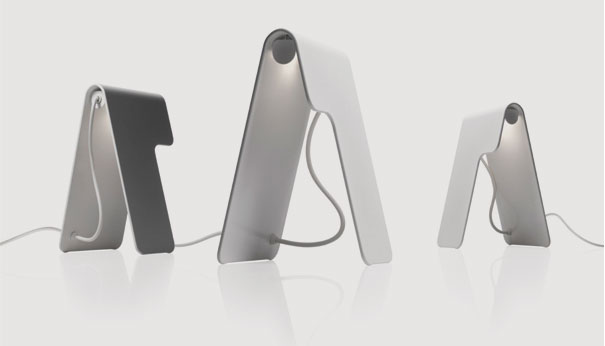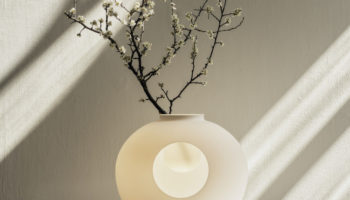Marco Zito’s Tua Table Lamp
Designer Marco Zito‘s Tua Table Lamp is deceptively simple. Constructed of a seemingly non-descript metal plane that Zito has discretely formed into the shape of a subtly-rounded capital A, Tua is stem and diffuser in one, providing an elegant alternative to the familiar separation between base and shade. Though, as Zito himself allows, the form may seem primitive, the concept is richly complex. In fact, after Listening to Zito talk for five minutes about the genesis and execution of the piece, one realizes that purity in design may not always be the divinely-inspired achievement it appears. That, in fact, a piece as ostensibly uncomplicated as Tua is richly significant–laden, in the manner of all good art, with layer upon layer of symbolic meaning.
Tua Table Lamp. Designed by Marco Zito.
Let’s try to unpack these various strata. First, there’s the original inspiration, a curved hand obscuring a bare source of light. As Zito explains, this is a prototypical gesture that’s perhaps the purest form of manipulation/alteration of a light source. Tua duplicates the motion in form and execution, as the lamp has the identical form and effect–that of muting and softening the harsh tones of direct light with a subtle diffusion and reflection, creating intimacy in a given space. Next, there’s the secondary inspiration of a “certain light in Venice” that Zito refers to. In this case, the mouth of a nearby bridge functioned as a shade and diffuser to the lights of the city behind it. The effect was equal parts elemental and beautiful, and Zito pays homage to it in the way Tua both captures and reflects ambient light.
Lastly, there’s the process of manipulation and refinement the designer alludes to in a succint demonstration: by simply folding a piece of paper and balancing it on a table, he demonstrates the concept in its earliest stage. Next, he proceeds to show the various experimental incarnations that led to the final product. Via the elimination of material (the artful incision on one side that gives Tua textural and sculptural interest) and the addition of the rounded apex that houses the light source, Zito achieves a lightpiece that’s rife with multiple interpretations. Among these is that of manufacturer Foscarini, who characterizes Tua as “a graphic sign and a functional lamp, which is always elegant, reassuring and friendly.”
Via MocoLoco.





Leave a Reply